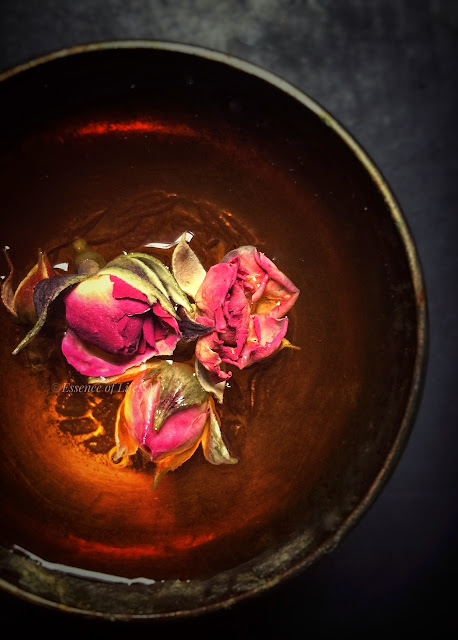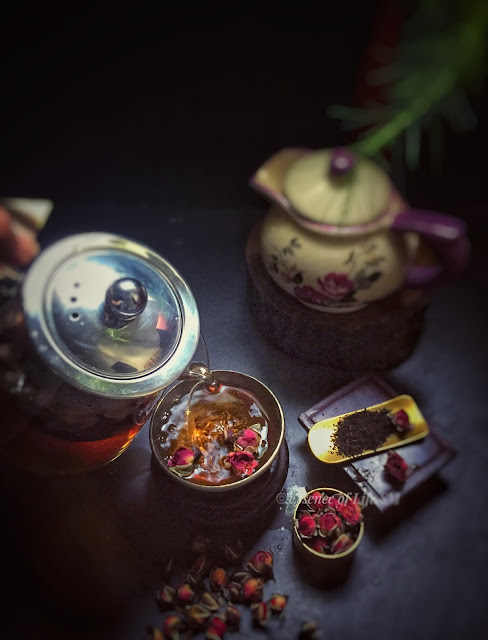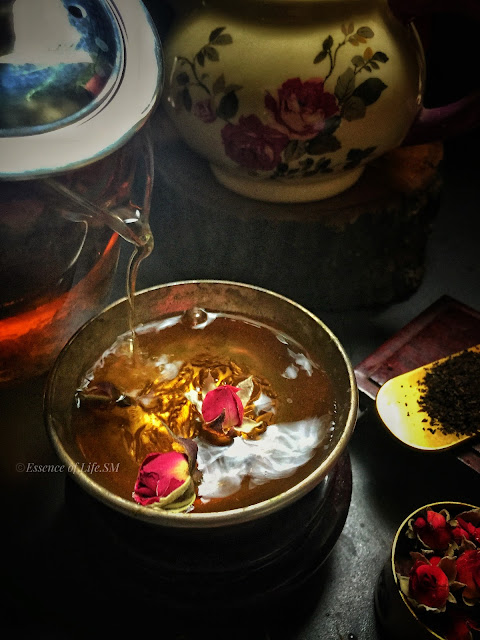Chinese Rose Tea - Essence of Tradition, Flavour and Therapeutic
 |
| "Unlock the Essence of Chinese Rose Tea: A Journey Through Tradition, Flavour, and Health Benefits." |
Unveiling the Delights of Rose Tea: A Journey Through History and Health
Living in Malaysia, where culinary diversity thrives, I found myself immersed in the rich tapestry of Chinese culture, particularly through its culinary treasures. One such delight that captivated my senses was Chinese Rose Tea. Often served in traditional Chinese restaurants, the allure of its unique aroma and delicate flavour enchanted me from the very first sip.
Though not typically a tea enthusiast, the experience of indulging in Chinese Rose Tea during dining outings never fails to invigorate me (and perhaps make me a tad hyperactive!). Among the various floral infusions, including Jasmine and Chrysanthemum, the Rose-flavoured variant stood out with its mild yet rejuvenating essence.
A Rose is a Rose is a Rose!!!
 |
| "Unlock the Essence of Chinese Rose Tea: A Journey Through Tradition, Flavour, and Health Benefits." |
Throughout the chronicles of time, roses have bewitched humanity with their ethereal beauty and captivating aroma. Yet, beyond their ornamental allure, these delicate blooms have been revered for centuries for their culinary and medicinal virtues. Among their myriad applications, rose tea emerges as a beverage steeped in tradition and brimming with wellness benefits. Let's traverse the epochs and delve into the fascinating tale of rose tea.
The saga of roses spans millennia, with traces of their existence discovered in ancient civilizations like Egypt, Persia, and China. In these ancient cultures, roses were not mere adornments but held profound symbolic and medicinal significance. The Egyptians crafted fragrant oils and perfumes from rose petals, while the Persians and Chinese integrated them into culinary concoctions and remedies.
 |
| "Unlock the Essence of Chinese Rose Tea: A Journey Through Tradition, Flavour, and Health Benefits." |
Origin of Rose Tea: China, steeped in its reverence for roses, entwined these blossoms into its tea culture with finesse. The Tang Dynasty (618-907 AD), an epoch renowned for its cultural zenith, witnessed the infusion of dried rose petals into green tea, black tea, and herbal blends. Renowned not just for its flavour but also for its therapeutic virtues, rose tea was hailed in traditional Chinese medicine for its cooling properties, aiding digestion, alleviating emotional stress, and fostering inner harmony.
The allure of rose tea transcended the borders of China, traversing continents to grace the tables of the Middle East and Europe. In Persia, rose water and petals lent their aromatic essence to a myriad of culinary delights, while European nobility indulged in rose-infused teas as symbols of opulence and refinement. Over time, rose tea evolved, with each region infusing its unique cultural nuances into the brew, be it through the addition of spices or herbs.
 |
| "Unlock the Essence of Chinese Rose Tea: A Journey Through Tradition, Flavour, and Health Benefits." |
In our contemporary milieu, rose tea retains its timeless charm, celebrated for its delicate flavour and potential health benefits. Crafted by steeping dried rose flowers or petals in hot water, rose tea offers a sensorial journey that soothes the soul and invigorates the senses. Beyond its tantalizing aroma, rose tea is lauded for its anti-inflammatory and antioxidant prowess, promoting skin health, bolstering immunity, and offering respite from menstrual woes.
From its ancient origins in the heart of China to its global influence on Persian and European cultures, rose tea stands as a testament to the enduring allure of botanical treasures. As you savour a cup of rose tea, relish in its rich heritage and the centuries of wisdom it embodies. Let its timeless essence transport you to realms of tranquillity and nourish your being, body, mind, and spirit alike. The gentle aroma of roses can promote relaxation and alleviate stress, offering a moment of tranquillity in a busy day.
Crafting & Mastering the Art of Brewing a Rose Tea:
 |
| "Unlock the Essence of Chinese Rose Tea: A Journey Through Tradition, Flavour, and Health Benefits." |
Crafting Chinese Rose Tea is a delicate art. Traditionally, the tea leaves are infused with fresh rose petals, infusing them with the flower's natural essence. Alternatively, high-quality teas may be scented with rose extract, offering a more affordable yet equally aromatic option.
Brewing the perfect cup of Chinese Rose Tea requires attention to detail. From water quality to steeping time, each element plays a crucial role in unlocking the tea's full potential. Remembering these key factors ensures a satisfying tea experience:
- Quality of the Tea: Start with the finest tea leaves for optimal flavour.
- Water Quality: Fresh, high-quality water enhances the tea's taste.
- Correct Measurement: Balance is key; use the right amount of tea for the desired strength.
- Steeping Temperature: Different teas require specific temperatures for optimal infusion.
- Brewing Time: Adjust steeping time based on tea type and leaf quality.
- Room for Expansion: Allow tea leaves and flowers to expand fully during steeping.
- Separation: Remove tea leaves and flowers promptly to prevent bitterness.
"Crafting Chinese Rose Tea: A Fragrant Journey of Tradition, Flavour, and Health Benefits"
 |
| "Unlock the Essence of Chinese Rose Tea: A Journey Through Tradition, Flavour, and Health Benefits." |
- Selecting the Finest Ingredients: For the best results, opt for premium loose tea leaves and the perfect variety of roses. When brewing rose tea, you have the choice of using either dried rose petals or buds. Look for fragrant roses like Rosa Damascena or Rosa Centifolia, renowned for their exquisite aroma and flavour, making them ideal for infusing your tea with a delightful floral essence.
- Water, the Elixir of Tea: To unlock the full potential of your rose tea, start with fresh, high-quality water. Avoid using water that has been previously boiled or left to sit, as it can impact the taste of your brew. Begin by heating water in a kettle until it reaches the ideal temperature for steeping your chosen tea leaves.
- Precision in Measurement: Achieving the perfect balance of tea and water is crucial for a harmonious infusion. While the exact measurements may vary based on the type of tea and the size of your teapot, a general guideline is to use one teaspoon of tea leaves for every six ounces or 3/4 cups of water.
 |
| "Unlock the Essence of Chinese Rose Tea: A Journey Through Tradition, Flavour, and Health Benefits." |
- Mastering the Art of Brewing: With water heated to the optimal temperature, carefully pour it over the tea leaves in your teapot. Allow the water to cascade gently, ensuring it envelops the leaves without rushing, preserving their delicate flavours. After pouring, take a moment to skim away any excess bubbles or loose leaves before securing the lid on your teapot.
Patience in Steeping: The duration of steeping plays a pivotal role in the development of your rose tea's flavour profile. While the size and quality of the tea leaves will influence the brewing time, it's essential to exercise patience and allow the tea to steep to perfection. For whole-leaf teas, a longer steeping time may be necessary, whereas high-quality teas may require a shorter duration.
 |
| "Unlock the Essence of Chinese Rose Tea: A Journey Through Tradition, Flavour, and Health Benefits." |
- Infusing with Roses: To enhance your rose tea experience, consider adding fresh or dried rose flowers alongside the tea leaves. This infusion of floral essence imbues your brew with an exquisite bouquet, elevating it to new heights of sensory delight. Ensure there is ample room for the tea leaves and roses to expand as they steep, allowing their flavours to meld seamlessly.
 |
| "Unlock the Essence of Chinese Rose Tea: A Journey Through Tradition, Flavour, and Health Benefits." |
Once brewed to perfection, Chinese Rose Tea delights the senses with its floral bouquet and delicate flavour profile. Gently transfer the brewed Teas from the Tea Pot or from a jug into the Tea Cups.
It's finally time to drink the tea. Good etiquette dictates that tea drinkers cradle the cup with both hands and enjoy the tea’s aroma before taking a sip. Traditionally, the cup should be drunk in three sips of different sizes. The first sip should be small; the second sip is the largest, the main sip; the third is to enjoy the aftertaste and empty the cup. With each sip, allow the delicate flavours of the roses to envelop your senses, transporting you to a realm of tranquillity and indulgence. Sipped slowly, it offers a moment of tranquillity amidst the hustle and bustle of daily life, making it a perfect choice for celebrating special occasions like Chinese New Year.
 |
| "Unlock the Essence of Chinese Rose Tea: A Journey Through Tradition, Flavour, and Health Benefits." |
As you embark on your journey with rose tea, remember that the art of
brewing is as much a science as it is an expression of passion. With
each cup, explore the nuances of flavour and fragrance that this
timeless elixir has to offer, and let it become a cherished ritual in
your pursuit of sensory delight.
 |
| "Unlock the Essence of Chinese Rose Tea: A Journey Through Tradition, Flavour, and Health Benefits." |
Enjoy The Pure Goodness of Chinese Rose Tea!!!
Wishing all my Chinese Friends a Happy Chinese New Year!
"Gong Xi Fa Chai"








0 comments